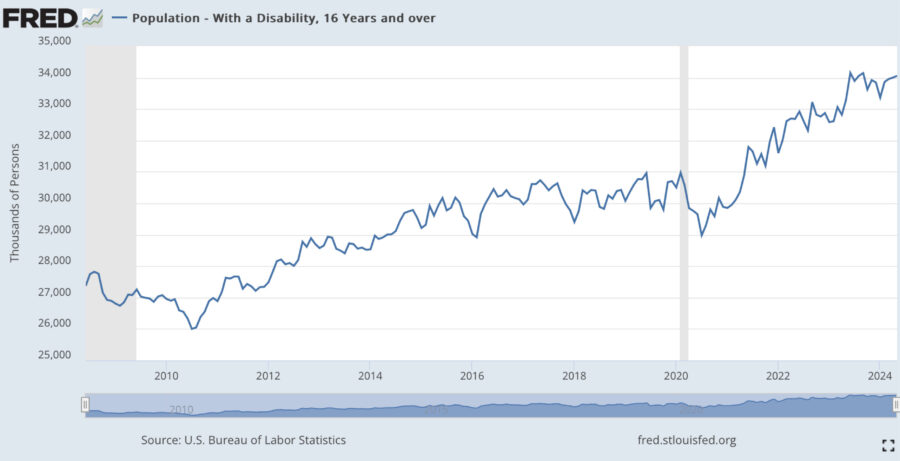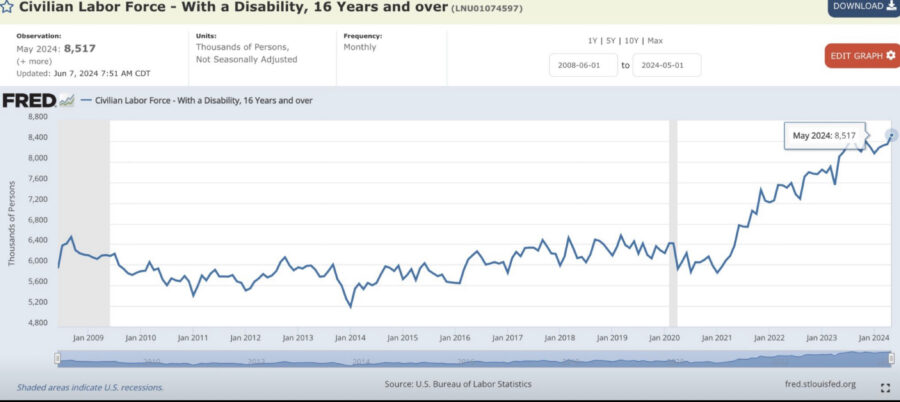Post-COVID disabilities increase puzzles experts

Along with the vexing rise in excess mortality numbers post-COVID, there has been a curious and significant increase in the number of working people with disabilities in the last three years. Health and policy experts are puzzled if there’s a connection between the two and some are scratching their heads over what has caused the number of workers claiming a disability to balloon.
The numbers are indeed compelling. In the 12 years from January of 2009 to January of 2021, the civilian labor force reporting disabilities was fairly stable, around 6 million a year, according to the U.S Bureau of Labor Statistics. Since 2021, the numbers have steadily climbed to the most recently reported level of 8,517,000 in January of this year.
What accounts for the sudden increase? Theories abound with some believing the pandemic can be blamed for various reasons and some contend more mundane causes related to greater acceptance or more job openings for disabled people in the workplace.
Or maybe more people are becoming disabled. The number of disabled people in the overall population has been steadily rising since 2011, most precipitously since 2020 when the numbers rose from 29.9 million to more than 34 million in May of this year, according to government figures.

Source: FRED, Federal Reserve Economic Data.
Disability disclosures, awareness on the rise
“We’re seeing a few things,” says Mike Ghesser, CEO and co-founder of Cleanlogic, a skin care company with a mission to increase the number of employed workers with disabilities. “First is a rise in Equal Employment Opportunity disclosure rates. This doesn’t mean there are more disabled people necessarily but can indicate more people with disabilities have been formally diagnosed and are disclosing to ask for accommodation. The second is a rise in awareness of disabilities and the work many activist groups are doing to raise that awareness.”
The rise has also come as medical advances have allowed more people to stay on the job, and new laws that have prohibited workplace discrimination against disabled people. Employers have long believed that hiring people with disabilities would increase health care costs, despite evidence to the contrary. Since many if not most disabled workers are employed part-time, they in many cases aren’t covered by workplace insurance programs. Still, Americans with disabilities do incur higher health care bills and are more likely than other workers to file for full-time disability benefits.
In the dark corners of the Internet one can find theories that the COVID vaccine itself is behind the rise in disabilities, but there’s little substantive evidence. Long-COVID, the lingering symptoms of the virus that some report, could be a factor.
But the more likely connection to the Pandemic, some believe, is the rise of at-home workers.

'Growth of remote work' cited in rise
“The rapid growth of remote work has created more opportunities for all workers, but in particular people with disabilities,” writes Adam Ozimek, of the Economic Innovation Group, a bipartisan public policy and research organization “Pre-pandemic workers with disabilities were overall more likely to work from home than non-disabled workers, according to 2019 data.”
Meanwhile, the U.S. group level disability insurance market is projected to rise steadily over the next several years, as a result of increasing awareness about the benefits of income protection and an aging workforce more susceptible to injuries and illness, according to a recent disability insurance market overview.
The report, by IBIS World found that disability insurance revenue has been growing at an annualized 1.0% over the past five years and exceeded a total of $23.9 billion in 2023. The biggest companies in the disability insurance business were The Hartford, UNUM, and Prudential, the report said.
“People with disabilities can, and do, do amazing work, and the awareness helps companies realize that employing people with disabilities actually gives them a competitive edge,” said Ghesser. “They get diverse perspectives that drive more innovation and foster a better culture. Personally, we try to advocate as much as possible and show other business owners that hiring people with disabilities only makes your company better.”
Doug Bailey is a journalist and freelance writer who lives outside of Boston. He can be reached at doug.bailey@innfeedback.com.
© Entire contents copyright 2024 by InsuranceNewsNet.com Inc. All rights reserved. No part of this article may be reprinted without the expressed written consent from InsuranceNewsNet.com.





How client review meetings can lead to business growth
Making the most of National Insurance Awareness Day
Advisor News
- Economist: Tariffs could dampen GDP growth; raise unemployment, inflation
- Medium tenure for workers remains at about 5 years
- Making the most of Financial Literacy Month
- Tariffs alter Q2 economic outlook downward, Morningstar says
- Women need an advisor who’s also a coach
More Advisor NewsAnnuity News
- Emerging digital annuity sales process cutting cycle times by 94%, IRI says
- In times of market volatility, FIAs make the difference
- Charitable gift annuities gaining in popularity
- Nationwide and Annexus establish first actively managed mutual fund within a RILA
- AM Best Comments on the Credit Ratings of Talcott Financial Group Ltd.’s Subsidiaries Following Announced Reinsurance Transaction With Japan Post Insurance Co., Ltd.
More Annuity NewsHealth/Employee Benefits News
- 5 trends shaping and challenging the insurance industry
- Health care costs bill signed by Lujan Grisham
- Friday roundtable in Rochester to focus on possible Medicaid cuts
- Studies from University of Southern California (USC) Yield New Information about Military Medicine (Health Insurance Coverage and Hearing Aid Utilization In Us Older Adults: National Health Interview Survey): Military Medicine
- Pritzker's Proposed Budget Will Take Away Health Coverage From Immigrants Without Legal Status
More Health/Employee Benefits NewsLife Insurance News
- 5 trends shaping and challenging the insurance industry
- Proxy Statement (Form DEF 14A)
- Symetra Partners with Nayya to Introduce Digital Leaving Planning Solution
- Krispy Kreme's owner is seeking approval to buy Shenandoah Life
- Krispy Kreme owner to acquire Roanoke-based Shenandoah Life
More Life Insurance News